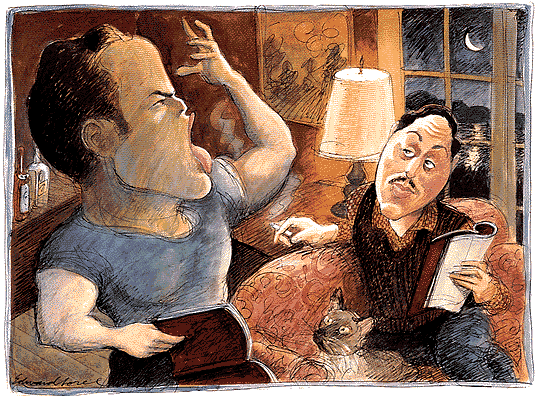Meanwhile, uptown, the Dominican boys don’t mess around. Last weekend, there they were, still playing baseball.
Monthly Archives: November 2011
Double Trouble
The Giants play the Eagles tonight. In honor of this old rivalry, check out our pal John Schulian’s classic portrait of Chuck Bednarik:
He really was the last of a breed. For 58 1/2 minutes in the NFL’s 1960 championship game, he held his ground in the middle of Philly’s Franklin Field, a force of nature determined to postpone the christening of the Green Bay Packers’ dynasty. “I didn’t run down on kickoffs, that’s all,” Bednarik says. The rest of that frosty Dec. 26, on both offense and defense, he played with the passion that crested when he wrestled Packer fullback Jim Taylor to the ground one last time and held him there until the final gun punctuated the Eagles’ 17-13 victory.
Philadelphia hasn’t ruled pro football in the 33 years since then, and pro football hasn’t produced a player with the combination of talent, hunger and opportunity to duplicate what Bednarik did. It is a far different game now, of course, its complexities seeming to increase exponentially every year, but the athletes playing it are so much bigger and faster than Bednarik and his contemporaries that surely someone with the ability to go both ways must dwell among them.
Two-sport athletes are something else again, physical marvels driven by boundless egos. Yet neither Bo Jackson nor Deion Sanders, for all their storied shuttling between football and baseball, ever played what Bednarik calls “the whole schmear.” And don’t try to make a case for Sanders by bringing up the turn he took at wide receiver last season. Bednarik has heard that kind of noise before.
“This writer in St. Louis calls me a few years back and starts talking about some guy out there, some wide receiver,” he says, making no attempt to hide his disdain for both the position and the player. “Yeah, Roy Green, that was his name. This writer’s talking about how the guy would catch passes and then go in on the Cardinals’ umbrella defense, and I tell him, ‘Don’t give me that b.s. You’ve got to play every down.’ “
“Concrete Charlie,” is also featured in Schulian’s recent collection: Sometimes They Even Shook Your Hand.
Observations From Cooperstown: Remembering Mickey Scott
If you’re a Yankee fan who’s never heard of Mickey Scott, I cannot fault you for that. I remember Mickey Scott, but not as a Yankee. It was only after his death in late October that I realized his connection to the Yankee franchise, not to mention his ties to central New York.
cannot fault you for that. I remember Mickey Scott, but not as a Yankee. It was only after his death in late October that I realized his connection to the Yankee franchise, not to mention his ties to central New York.
Scott did not follow the traditional path to the major leagues. He was born in Weimar, Germany, to a military family that eventually settled in New York state. Scott grew up in Newburgh, located about 60 miles north of New York City. In 1965, the year of the first amateur draft, the Yankees took Scott on the 17th round out of Newburgh Free Academy. Given the rough winter weather in much of upstate New York, relatively few major leaguers have come out of the state from locations north of the city. But the Yankees liked Scott’s live left-handed arm enough to counteract any concerns they had about the small sample size of Scott’s work.
The skinny southpaw quickly showed the Yankees that he had enough stuff and experience to pitch professionally. He pitched brilliantly at two stops in 1965, before putting in a full season at Single-A Binghamton in 1966. He won a league-leading 15 of 20 decisions for the Triplets, held NY-Penn League opponents to a 2.75 ERA, and led the league in strikeouts.
With his career on the verge of a breakthrough, the realities of the late-1960s put up a roadblock. Scott missed all of the 1967 season while serving the military during Vietnam. Like most of the Vietnam vets, he didn’t receive much credit or applause when he returned to civilian life.
Undeterred by the setback, Scott came back to pitch in 1968, returning once again to Binghamton. But the Triplets had now moved up to Double-A status as a member of the Eastern League, so Scott’s return to Binghamton actually represented an impressive jump for the 20-year-old lefthander. Scott lowered his ERA to 2.58 while allowing only 83 hits in 115 innings. Though not overpowering, Scott convinced the Yankees he was now a legitimate prospect.
The following summer, the 21-year-old Scott moved up to Triple-A Syracuse, another location in upstate New York. It was an impressive ascension for a 17th-round draft pick. Like a lot of young lefthanders, Scott struggled with his first taste of Triple-A hitters. Now deeming him expendable, the Yankees traded Scott to the White Sox for Pete Ward, a combination first baseman/third baseman with some lefty power. Ward would last one unproductive season in the Bronx before calling it a career, while Scott would never pitch a game for the ChiSox.
In September of 1970, the Sox traded Scott to the Orioles. The Orioles switched him to the bullpen, where he used a devastating change-up to become the lefty relief ace for the Rochester Red Wings. He also became popular with teammates, who appreciated his upbeat nature and keen sense of humors. In 1972, Scott would finally make his big league debut for the pitching-rich O’s. Scott pitched well in 15 games, kicking off a journeyman career that would last five seasons and include stops in Montreal and California. Used mostly as a relief pitcher, Scott put up a 3.72 ERA in 172 innings.
Scott never pitched a regular season game for the Yankees, but that would not prevent an eventual reunion with the franchise. Appreciating his attitude and work ethic, the Yankees hired Scott to fill a number of duties, including a role throwing batting practice at Yankee Stadium. He threw BP to such notables as Thurman Munson, Reggie Jackson, Roy White and Graig Nettles.
When not in the Bronx, Scott returned to his residence in Binghamton, a place that became so special to him that he settled on it as his permanent home. He opened up a bar called “Mickey’s Mound,” where the personable and outgoing left-hander often regaled visitors with stories of his life in both the majors and the minors. During the 1980s, Billy Martin moved near the Binghamton area and frequently visited Mickey’s Mound. There Martin and Mickey became good friends.
Though Scott no longer owned the bar, he seemed to be enjoying retirement in Binghamton. He kept himself in good shape, regularly visiting a local gym to keep his weight and conditioning under control. On October 30 of this year, Scott called his mother from his home in Binghamton and told her that he was heading outside to rake some leaves, a common fall chore in upstate New York. Scott never returned to the house. While on his front lawn, he suffered a heart attack. His body was found by two women who happened to be walking by. Scott was 64.
I didn’t know that Mickey Scott lived in Binghamton or had a bar there until I read stories reporting his death. As a resident of Cooperstown, I live only about an hour’s drive from Binghamton. I wish I had known about Mickey’s Mound back in the 1990s; I would have enjoyed saddling up to the bar, ordering a ginger ale, and hearing a few stories from Mickey Scott himself.
Sadly, I never had the chance. But I know that others did. And I would love nothing more than to hear some of those stories about Mickey Scott.
Bruce Markusen writes “Cooperstown Confidential” for The Hardball Times.
Big Sexy
Not long ago I was thinking about the first crush I had on a TV or movie star. Linda Carter, Bo Derek, and Catherine Bach all came to mind. Valerie Bertinelli, Ann Jillian, and Deborah Harry, too. Then it hit me: It was Julie Newmar as Catwoman. I used to watch Batman in syndication during the afternoon. Must have been four or five years old. Catwoman was always messing with Batman’s head, dressed in that tight outfit, getting all close to him and whispering in his ear, ready to pounce. Yup, Julie Newmar was dangerous, the first sex symbol I fell in lust with.
Taster’s Cherce
I’m forever messing up pears. I just can’t get a handle on them. So many different varieties and consistencies. I like them raw and I liked them cooked but it’s going to be awhile before I figure out how to cook them properly. Hell, I can’t seem to buy the right ones to eat just like that.
That said, this looks tasty. I like the idea of the vanilla.
Long live Smitten Kitchen.
Color By Numbers: It’s A Major Award
The offseason awards season hasn’t been very kind to the Yankees so far. Ivan Nova and C.C. Sabathia, the team’s respective candidates for the Rookie of the Year and Cy Young, both finished a distant fourth in the voting, but at least that was one slot ahead of manager Joe Girardi, who placed fifth in Manager of the Year balloting. With only MVP left to consider, and Curtis Granderson considered somewhat of a long shot, chances are the Yankees will wind up empty handed.
Yankees’ Historical Award Totals
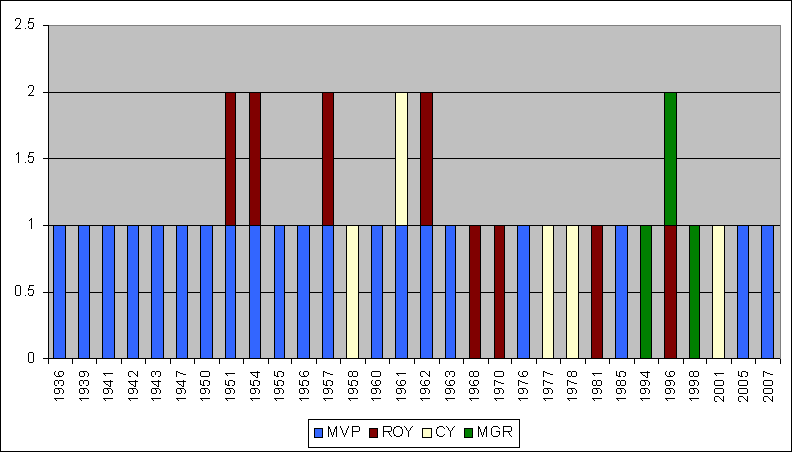
Note: MVP first awarded in 1931; RoY in 1947 (one award until 1949); CY in 1956 (one award until 1967); MoY in 1983
Source: mlb.com
To go along with all of the franchise’s other accolades, the Yankees have had more MVPs than any other team, and also rank among the leaders for all of the other major awards. However, since 1985, only seven awards have been handed out to the pinstripes, and three of those were to the manager. Many Bronx Bomber fans probably view this as evidence of bias against the team within the ranks of the BBWAA, but it might also speak to how well rounded the Yankees have been over the last two decades.
Top Major Award Winners, by Franchise
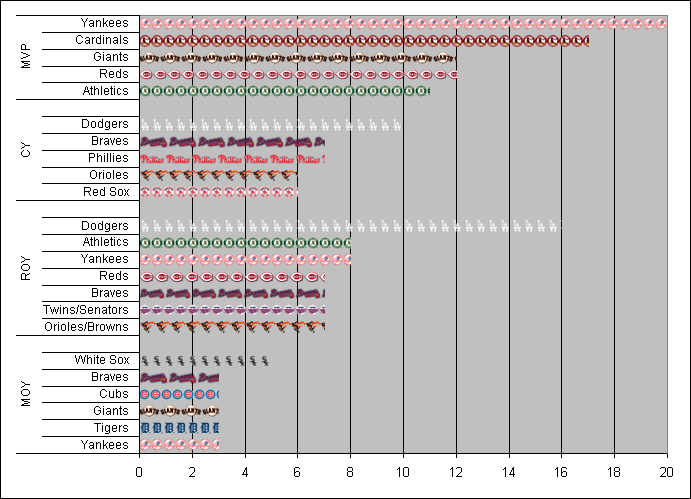
Source: mlb.com
Since the award was first bestowed upon Jackie Robinson in 1947, the Rookie of the Year has become synonymous with the Dodgers. With four honorees while in Brooklyn and 12 while in Los Angeles, the Dodgers have consistently churned out talented youngsters. The franchise’s 16 Rookie of the Year trophies not only equal the combined total of the next two teams, but also include two stretches of at least four consecutive winners, each of which alone would sum to more awards than the individual totals for 18 other teams. What makes the Dodgers’ RoY dominance even more impressive is the award requires a new winner every season, so having one or two great players doesn’t account for the lion’s share of a team’s total.
Along with the Athletics, the Yankees lead the American League with eight Rookie of the Year winners, but Derek Jeter has been the franchise’s only honoree since Dave Righetti won the award in 1981. Jesus Montero has a good chance to break that drought in 2012, assuming the Yankees are able to find him a position. In the almost 40 years since the DH was created, only the Royals’ Bob Hammelin, who bested Manny Ramirez, has won the Rookie of Year by taking most his at bats as a designated hitter. At this point, that seems to be the Yankees’ plan for Montero, so in order for him to win the honor next season, he’ll have to buck that historical trend.
Rookie of the Year Winners, by Position and League
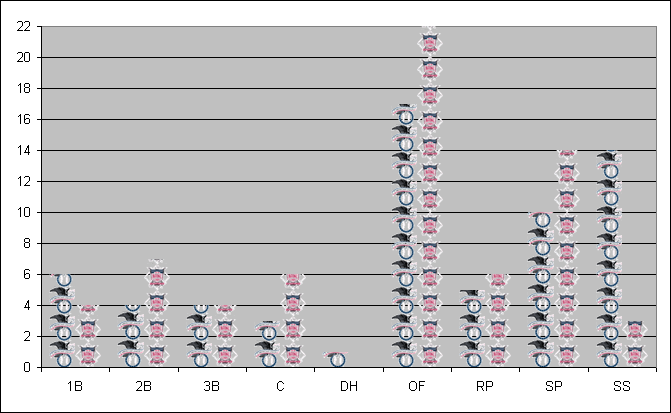
Note: Players considered only at the position they played the most.
Source: mlb.com
Manager of the Year is perhaps the most nebulous of the four major awards. Apparently, a successful manager is not only judged by the performance of his team, but by the lack of payroll allotted to it. That’s unfortunate for Joe Girardi now, but, when he became the only MoY to win the award with a losing record while with the Marlins in 2006, it was Willie Randolph who was left to lament.
Although the MoY is the most recent of the major awards, it rivals the RoY in terms of broad distribution. Only the Mets and Brewers have never had a manager win the honor (the Diamondbacks are the only team without a RoY), meaning more teams have had MoY designees than the Cy Young and MVP (25 teams each), both of which have been around much longer.
This year, both MoY selections made a bit of history. In the A.L., Joe Maddon became the 12th manager to win the award at least twice, while in the N.L., Kirk Gibson joined an even more select fraternity. Along with his 1988 MVP, Gibson’s MoY award makes him only the four person to win both trophies, joining Joe Torre, Frank Robinson and Don Baylor.
Multiple Manager of the Year Winners

Source: mlb.com
To no one’s surprise, Justin Verlander was unanimously selected as Cy Young in the American League, making him only the 14th different pitcher (and 21st selection) to be so honored. Verlander was also the first Tigers’ starting pitcher to win the award since Denny McLain won it consecutively in 1968 and 1969. Among the pitchers Verlander beat out for the award was C.C. Sabathia, who finished a distant fourth (the big lefty has finished no lower than fourth in the balloting during all three of his seasons in pinstripes). Although Sabathia didn’t seem to get much serious consideration for the top of the ballot, it’s worth noting that fangraph’s version of WAR actually had the Yankees’ ace leading the American League.
In the National League, Clayton Kershaw was named Cy Young, becoming the youngest pitcher to win the award since a 20-year old Dwight Gooden in 1985 and adding to the Dodgers’ major league leading total of 10 honorees. In order to win the award, Kershaw had to beat out reigning Cy Young Roy Halladay, who led the National League in both versions of WAR. Perhaps the electorate has grown a little weary of honoring Halladay, but even so, it’s hard to argue with Kershaw credentials.
Unanimous Cy Young Award Winners
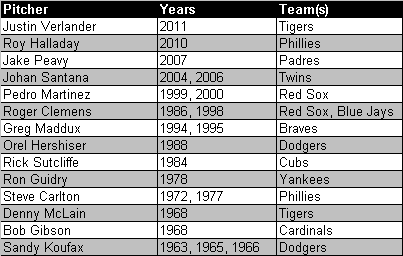
Source: mlb.com
This year’s MVP vote in the American League could be among the closest ever. In addition to prominent candidates from most of the contending teams, Jose Bautista had another phenomenal season, so there is no lack of deserving winners. However, most of the attention has revolved around whether Verlander could, or should, win both the MVP and the Cy Young.
In the 55 years of concurrent history between the two awards, nine pitchers have been named both Cy Young and MVP, and of that total, three of the last four have been relief pitches. So, needless to say, the BBWAA has been at least a little reluctant to give the MVP to a player who takes the field less than 40 times per season. But, was Verlander’s 2011 campaign strong enough to mitigate that reticence?
Players Who Have Won Two Major Awards in One Season
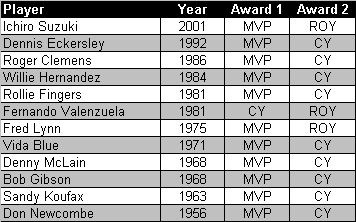
Source: mlb.com
Regardless of where you come down on the Pitcher-as-MVP debate, Verlander stands on the verge of an even more select accomplishment. Should the Tigers’ right hander add to his trophy case next week, he’ll join Don Newcombe as the only player to be honored as a RoY, Cy Young, and MVP. The Newk, who was voted the top rookie in both leagues for 1949, was named MVP and Cy Young five seasons later in 1956 (he missed three years to his service in the Korean War). If Verlander is similarly honored, he will have taken the same path to join Newcombe.
In the National League, the MVP race seems to be a two horse race, with Ryan Braun having the edge over Matt Kemp because of the relative success of his team. If the two players do finish 1-2, it would be appropriate for several reasons, not the least of which is both men recently signed mega-contract extensions that will pay them over $20 million per season into the next decade. Needless to say, the Brewers and Dodgers will be hoping this isn’t the last time Braun and Kemp find themselves atop the MVP balloting.
MVP Winners, by Position and League
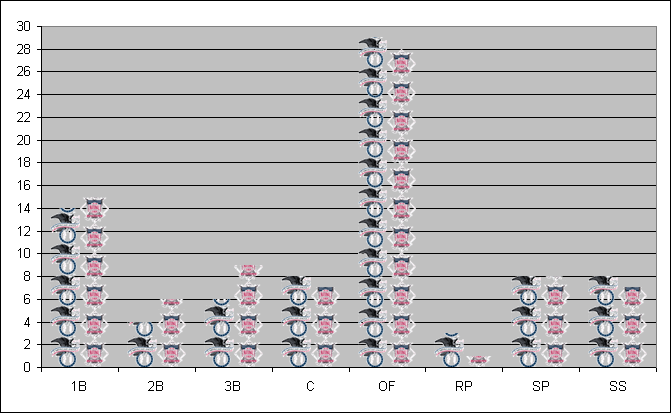
Note: Players considered only at the position they played the most.
Source: mlb.com
The baseball awards season not only provides a cap on the current year, but also the perfect segue into the Hot Stove. Before too long, fans will be digesting their team’s winter acquisitions and projecting which players are poised for a break-out season. Among that group could be next year’s major award winners, but those future Cy Youngs, RoYs and MVPs will have to wait. The spotlight still belongs to this year’s Boys of November.
New York Minute
The local was running behind schedule this morning so the conductor announced that after 72nd Street the 1 train was going express to Times Square, bypassing my stop in the process. I got off at 72nd and took one step to the side of the door onto the platform. My left foot was maybe six inches away from the ledge and I had to look away as the train pulled out of the station so I wouldn’t get dizzy. Then, as we waited for the next train to approach, I looked back at the faces huddled behind me and then shifted my weight on my back leg, away from the tracks. I was less than a foot away from disaster but not sensible enough to lose my spot.
[Photo Credit: Rob Brulinski]
Flip the Script
After next season the Houston Astros will play in the American League West. Two extra teams will be added to the playoffs in 2013, as well.
Taster’s Cherce
I’ve tuned into the Nathan’s Hot Dog eating contest a few times. I’d never consider joining an eating contest, but I like a good gross-out as much as the next guy.
Eating challenges, on the other hand, those intrigue me. The Old ’96er for instance. There’s a whole show dedicated to them on the Travel Channel. The few times I’ve been to places that offered a challenge, I was tempted to try it.
Up all night on Monday at a concert in Newark, I was empty this Tuesday at lunch. I ordered this:
That’s a Grand Slam from Go Go Curry. A chicken cutlet, a pork cutlet, an egg, two sausages, a fried shrimp all covered in a thick, brown curry. There’s a pile of shredded cabbage on the side. And underneath all that is a mountain of rice. With nothing on the line but my pride and my 12 bucks, I bid adieu to all but the rice. The rice just kept coming and I ended up leaving about a handful on the plate.
Maybe if I wasn’t headed back to work and if I didn’t have to play basketball that night, maybe I could have taken it down. But I was happy I left it there.
How about you guys – what was your biggest eating challenge?
Million Dollar Movie
Sunday and Monday on American Masters:
Watch Woody Allen: A Documentary on PBS. See more from AMERICAN MASTERS.
Never Say Die
Richard Hoffer is one of the best writers to ever cover sports in this country, first at the L.A. Times and then at Sports Illustrated. His prose is graceful and precise, he’s understated and funny.
Here is he on Joe Frazier and Muhammad Ali in the current issue of SI:
It was no wonder Joe Frazier was so bitter. He was made to seem the foil, a mere accomplice in mythology, consigned to a supporting role in Muhammad Ali’s extravagant, ego-driven drama. It is a harsh truth that if you participate in the most exciting rivalry of a century, it does you little good even to win one of its three bouts. The verdict of history is decisive, and it is permanent, and men like Frazier, who stumble at the precipice, are forever remaindered on the heap of losers, their vinegary claims to justice lost in the courts of public opinion. It was no wonder, then, that when Ali lit the Olympic torch in 1996, his trembling hands viewed as a physical artifact of heroism by an adoring world, Frazier allowed that if he’d had his way, he’d have pitched Ali into the fire.
…In 1975—Ali now 33, Frazier 31—they met again in the near-death experience that would ever after be known as the Thrilla in Manila. Ali was even crueler in his prefight taunts, exploiting the fact that gorilla rhymed with the venue. Frazier, by turns mystified and hurt, was provoked beyond the requirements of the bout. While Ali would always say he was only boosting the box office, Frazier could never accept any explanation for attacks that might affect his children’s impression of him. “Look at my beautiful kids,” he’d say. “How can I be a gorilla?”
But not even animus could account for what happened that morning in the Philippines. It was such a violent affair—recklessness tilting it first Ali’s way, then Frazier’s way and then Ali’s again—that it seemed less a boxing match than an exploration of man’s capacities, a test of his will to win or at least survive. But once it turned Ali’s way again in the 12th round, too much had gone before for yet another reversal. There wasn’t anything left in either man. Before the 15th and final round Frazier’s trainer, Eddie Futch, called it quits, saving his fighter from certain ruin, even as Ali was instructing his corner to cut his gloves off. It was victory, but by attrition.
Ali called it “the closest thing to dying I know of,” and he didn’t know the half of it. Their careers were essentially over that day, their 41 rounds of shared agony making any further discoveries in the ring unnecessary, or even possible. Frazier lost a rematch to Foreman and called it quits. Ali managed to dominate the game for several years more, but only on the basis of his personality—he was spent. Even then he was beginning a slow and ironic decline, Parkinson’s eventually rendering him rigid and mute, the final price for all those wars.
Ali’s respect for Frazier was enormous, and he apologized for his name-calling on several occasions. “I couldn’t have done what I did without him,” he once said.
Frazier repaid the compliment: “We were gladiators. I didn’t ask no favors of him, and he didn’t ask none of me.” They recognized that their destinies were entwined, that neither would have achieved his greatness without the other. But Ali could afford to concede the point, being the most popular athlete, even personality, in the world. Frazier, who spent the rest of his life living above his gym in Philadelphia, did not have the comfort of the world’s goodwill—he lived in an age that would reward style over substance every time—and so maintained his half of the blood feud as vigorously as possible, even seeming to take a grim satisfaction in Ali’s poor health, proof of who really won that day in Manila.
That a feel-good reconciliation would elude the two men who shaped such a magnificent rivalry is apt. Even if they were more like brothers than foes—who else could understand the kind of pride that forced them through those three battles?—fighters like them could never really enjoy a cease-fire, could never drop their hands, as if they alone knew what man was truly capable of.
Couple Few Things
Some baseball stuff.
Over at Fox Sports, Ken Rosenthal weighs in on the search for a new manager in Boston.
Meanwhile: a look at the Mets’ new uniforms; Eric Chavez wants to play next year; Ben Kabak on Yu Darvish; Steven Goldman on Ivan Nova, and William J on Joe Girardi’s lack of support for Manager of the Year.
[Photo Credit: Oyl in Tokyo]
Beat of the Day
[Photo Credit: N.Y. Times]
--Earl Weaver






















